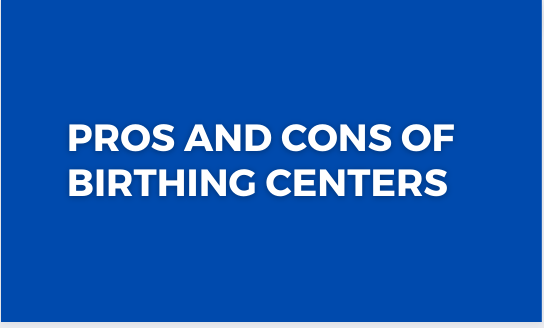Birthing centers offer an alternative to traditional hospital births, providing a more intimate and holistic approach to childbirth. While birthing centers have gained popularity, it’s important to consider both the advantages and disadvantages they present. In the following list, we present pros and cons of birthing centers to provide a comprehensive understanding of this birthing option.
Pros:
- Personalized care: Birthing centers offer personalized, individualized care and support throughout the childbirth process.
- Homelike environment: The ambiance of a birthing center resembles a cozy home, creating a comfortable and relaxed atmosphere for labor and delivery.
- Lower intervention rates: Birthing centers tend to have lower rates of medical interventions, including cesarean sections, inductions, and epidurals.
- Choice and autonomy: Women have more control and autonomy over their birthing experience, including birth positions, pain management options, and movement during labor.
- Continuity of care: Women receive consistent care from a team of midwives or healthcare providers they have built a relationship with throughout pregnancy.
- Support for natural childbirth: Birthing centers emphasize and support natural childbirth methods, such as breathing techniques, relaxation, and non-pharmacological pain relief.
- Family-centered care: Birthing centers involve partners and family members in the childbirth process, fostering a supportive and inclusive environment.
- Increased privacy: Birthing centers provide greater privacy compared to hospital settings, allowing women to labor and birth in a more intimate setting.
- Reduced medical interventions: With a focus on natural childbirth, birthing centers promote fewer unnecessary medical interventions.
- More time for postpartum bonding: Women and their families are given extended postpartum recovery time, allowing for enhanced bonding and breastfeeding initiation.
- Education and empowerment: Birthing centers prioritize education and empowerment, providing women with information and resources to make informed decisions about their care.
- Support for breastfeeding: Birthing centers offer breastfeeding support and education, promoting successful breastfeeding initiation and continuation.
- Holistic approach: Birthing centers emphasize holistic care, addressing not only the physical aspects of childbirth but also the emotional, psychological, and spiritual well-being of women.
- Lower cost: Birthing centers are generally more cost-effective than hospital births, reducing financial strain on families.
- Lower infection rates: Birthing centers often have lower rates of hospital-acquired infections, as they are less exposed to hospital pathogens.
- Flexible visitation policies: Birthing centers often have more flexible visitation policies, allowing women to have a supportive network of family and friends present during labor and delivery.
- Freedom of movement: Women are encouraged to move and change positions freely during labor, facilitating a more active and comfortable birthing experience.
- Less medical equipment: Compared to hospitals, birthing centers typically have less medical equipment, creating a less clinical and intimidating environment.
- Natural pain management options: Birthing centers offer various natural pain management options, such as hydrotherapy, massage, and birthing balls.
- Comprehensive postpartum care: Birthing centers provide comprehensive postpartum care, including lactation support, newborn care education, and emotional support.
Cons:
- Limited access to medical interventions: In emergency situations or complications, birthing centers may have limited access to necessary medical interventions.
- Risk assessment limitations: Birthing centers may have limitations in conducting certain high-risk assessments during pregnancy or labor.
- Distance to emergency care: Birthing centers are often located at a distance from hospitals, which can increase travel time in case of emergencies.
- Higher transfer rates: In some cases, women may need to be transferred to a hospital if complications arise during labor or delivery.
- Lack of pain management options: Compared to hospitals, birthing centers may have limited pain management options available.
- Limited access to epidurals: Epidurals, a popular pain relief option, may not be available in birthing centers.
- Staff availability: Birthing centers may have limited staff availability, which can impact response times and support during labor and delivery.
- Insurance coverage limitations: Not all insurance providers cover birthing center births, resulting in potential out-of-pocket expenses.
- Limited postpartum monitoring: Birthing centers generally have a shorter postpartum monitoring period compared to hospitals.
- Lack of immediate medical attention: In case of complications, immediate medical attention may be delayed in birthing centers compared to hospitals.
- Less access to specialized care: Birthing centers may have limited access to specialized medical care for certain conditions or emergencies.
- Incompatibility with high-risk pregnancies: Women with high-risk pregnancies may not be eligible for birthing center care due to the need for closer medical supervision.
- Limited pain relief options: While birthing centers prioritize natural childbirth, women seeking extensive pain relief options may find them limited.
- Non-24/7 availability: Birthing centers may not be available 24/7, potentially leading to logistical challenges and unpredictability.
- Transportation concerns: The need for transportation to and from the birthing center can add complexity and stress to the birthing process.
- Limited medical equipment and monitoring: Compared to hospitals, birthing centers may have fewer medical equipment and monitoring capabilities.
- Potential for psychological distress: In cases of unexpected complications, birthing center settings may cause psychological distress for women and their families.
- Limited options for cesarean birth: Birthing centers may not offer cesarean birth options, necessitating transfer to a hospital in such cases.
- Lack of neonatal intensive care: Birthing centers generally do not have neonatal intensive care units, limiting care options for babies with immediate medical needs.
- Limited insurance reimbursement: Some insurance providers may offer limited reimbursement or coverage for birthing center births, increasing financial burdens for families.
Pros
- Personalized care
- Homelike environment
- Lower intervention rates
- Choice and autonomy
- Continuity of care
- Support for natural childbirth
- Family-centered care
- Increased privacy
- Reduced medical interventions
- More time for postpartum bonding
- Education and empowerment
- Support for breastfeeding
- Holistic approach
- Lower cost
- Lower infection rates
- Flexible visitation policies
- Freedom of movement
- Less medical equipment
- Natural pain management options
- Comprehensive postpartum care
Cons
- Limited access to medical interventions
- Risk assessment limitations
- Distance to emergency care
- Higher transfer rates
- Lack of pain management options
- Limited access to epidurals
- Staff availability
- Insurance coverage limitations
- Limited postpartum monitoring
- Lack of immediate medical attention
- Less access to specialized care
- Incompatibility with high-risk pregnancies
- Limited pain relief options
- Non-24/7 availability
- Transportation concerns
- Limited medical equipment and monitoring
- Potential for psychological distress
- Limited options for cesarean birth
- Lack of neonatal intensive care
- Limited insurance reimbursement



